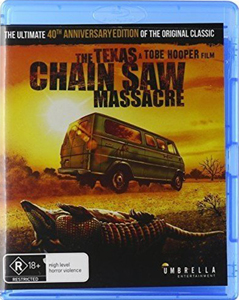“The Texas Chain Saw Massacre” (1974) is perhaps the first slasher film, or at least a proto-slasher, depending on how you reckon it. Marilyn Burns, as Sally, is arguably the first Final Girl, and certainly a Scream Queen who earns that label, especially in the conclusive dinner-table scene.
Yet when I talk about influential slasher movies with my friends, “Chain Saw” is not brought up as often as “Halloween” (1978) and later films, and I think it’s partially because it’s too good at what it does, especially when Burns so convincingly portrays her horror as a family of cannibals tries to kill her.
The fact that it didn’t immediately spawn sequels (there are now seven more films, but the first sequel didn’t come out till 1986, and it’s a comedy) also makes “Chain Saw” get overlooked. And it might also miss out on slasher qualification because all five teens travel to Leatherface’s (Gunnar Hansen) house, where he then kills them.
None of them have to be stalked, except Sally, and that’s only because she temporarily gets away and Leatherface chases her through the barely moonlit woods. The quintet would’ve been fine – even after picking up The Hitchhiker (Edwin Neal, brilliantly setting the uneasy tone) – if they didn’t have the bad luck of going to this particular house to ask for gasoline.
From trash to classic
Regardless of its classification, the history of how “Chain Saw” is viewed by the public is fascinating – first as trash, then as dark or unintentional comedy, and finally as a genre classic. It was initially considered to be the violence version of pornography. But, as you’ve no doubt heard if you’ve done minimal research on the film, the most shocking scene includes no blood or gore.
Director Tobe Hooper gives a close-up of the meat hook, Leatherface places Pam (Teri McMinn) on the hook but it’s shot from the front so no special effect is needed, and then McMinn acts like she’s wriggling on the hook.
Viewers in the 1970s remembered the scene as being bloody — and perhaps even including a frame of hook penetrating skin — only because Hooper’s shooting and editing tricked them.
That said, a practical effect – the creation of The Grandfather (John Dugan) through prosthetic makeup – contributes to the most chilling part of the movie. On my first viewing, I thought he was a corpse, like Norma Bates at the end of “Psycho.” Instead, he’s so ancient that he merely looks dead.
It perks our imaginations
The screenplay by Hooper and Kim Henkel – in a macro version of that meat-hook scene – is a lot sparser on information than we remember. But something about it perks our imaginations.
That dinner sequence has a religious quality in the way it’s important for Leatherface, the Hitchhiker and The Old Man (Jim Siedow) to get The Grandfather to strike the killing blow on Sally with the hammer. When The Grandfather sucks blood from Sally’s finger, we can imagine it’s part of a life-extending ritual.

The climactic chaotic weirdness comes on the heels of a slowly building film that gets under our skin in almost subliminal ways. The opening crawl (voiced by John Larroquette, of all people) suggests this is based on a true story, two decades before “Fargo” used the ploy. No doubt at least some 1970s viewers wondered if this was indeed a true story.
In lieu of a score, we often hear radio broadcasts in the background, vaguely reporting the recent graveyard robberies (part of the cannibals’ operations, albeit probably for their artistic endeavors rather than meat production) and other violent news from around the world.
The house’s generator sounds a bit like a chainsaw, but also like a filmstrip projector, further emphasizing the “true story” and “news reel” vibes. A cheerful song plays on the radio when The Old Man attacks Sally at the barbecue joint, a minor version of what would become a genre cliché of radio hits being made creepier when played behind horrific events.
Burns sells it
In a lesser overall film, the dinner sequence might be seen as trash, or an example of a potentially good movie riding off the rails into unintentional comedy. But it comes on the heels of all this buildup, and also, Burns sells it with her terror. Sally actually gets away at the end, having jumped out a window to daylight, emphasizing to viewers both the horrifying fact that she’s been going through this ordeal all night and the relief of her escape.
After a semi-trucker and a pickup driver stop and get involved in the chase (without so much as an utterance of shock, remarkably), Sally escapes in the back of the pickup. Her screams turn into laughs more maniacal than The Old Man’s cackle, suggesting that she has escaped with her life but not her sanity.
Through sheer aggressive acting, Burns infuses permanent tragedy into Sally’s story. And isn’t that how it would be? As horror viewers, we like to think escape means a return to normalcy, but in reality, a person would be haunted for life by such events.
Sally is one of those Final Girls who emerges into that role; she’s not the obvious last survivor from the get-go like Laurie Strode or Sidney Prescott. Also among the van-journeying hippies (in another example of the film’s sparse info, we don’t know the ultimate goal of the road trip) are other earthy performances, notably Paul A. Partain as wheelchair-bound flashlight hog Franklin.
In the boonies
These young people might represent a counterculture in reaction to square adults, but “Chain Saw” soon illustrates a scarier third type of person: crazy people living unrecognizable lifestyles in the boonies.
What makes the movie scary is not just that they are crazy, but also that they have a twisted logic of their own. From their point of view, The Hitchhiker is a hunter, Leatherface is a butcher and The Old Man is a cook. “Chain Saw” makes us confront something we don’t like to think about: Humans are meat, like the cattle referenced early in the film.
That’s driven home not just by the hard-working Leatherface’s meat production system, but also by the fact that the cannibal family does not see the travelers as anything but meat.
When The Old Man tells Sally it won’t hurt much to be killed, I think he’s trying to quiet her screams more so than having human compassion. And yet he is by far the most compassionate one, noting that he doesn’t enjoy killing.
In his “Last Drive-In” episode about this movie, horror expert Joe Bob Briggs defends the teens who wander into Leatherface’s house, noting that that’s what people did at the time. They don’t anymore – because they saw this movie. “Chain Saw” no doubt did a lot to encourage or exacerbate people’s mistrust of strangers – which is a bad thing culturally but an amazing achievement artistically.
Ultimately, Hooper’s (and Henkel’s and Burns’) ability to manipulate viewers is what fooled stuffed shirts into thinking “The Texas Chain Saw Massacre” is a form of pornography. It’s more akin to a magic trick.
Click here to visit our Horror Zone.

“Texas Chainsaw Massacre” series reviews
“The Texas Chain Saw Massacre” (1974)
“The Texas Chainsaw Massacre 2” (1986)
“Leatherface: The Texas Chainsaw Massacre III” (1990)
“Texas Chainsaw Massacre: The Next Generation” (1995)
“The Texas Chainsaw Massacre” (2003)
“The Texas Chainsaw Massacre: The Beginning” (2006)
“Texas Chainsaw” (2013)
“Leatherface” (2017)


